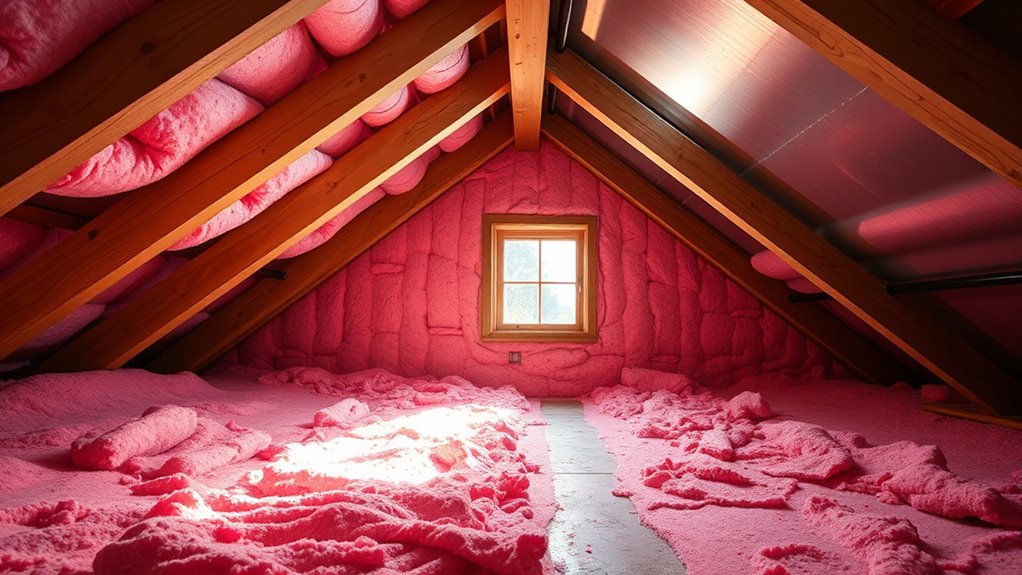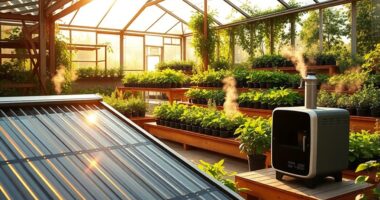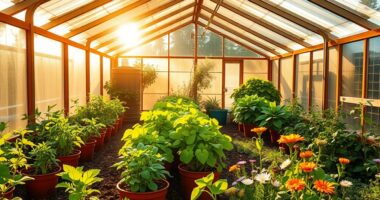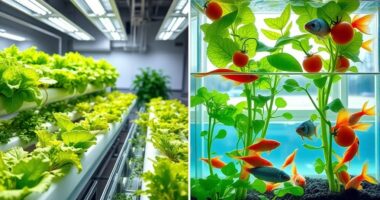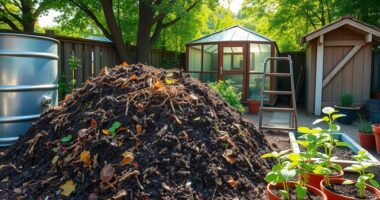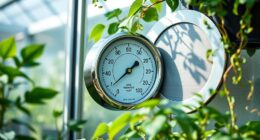To boost your home’s energy efficiency, focus on upgrading insulation, adding thermal mass, sealing gaps airtight, and installing energy-efficient windows and doors. Good insulation and thermal mass help stabilize indoor temperatures naturally, reducing your reliance on heating and cooling. Airtight sealing prevents drafts and improves overall insulation performance, while energy-efficient windows minimize heat transfer. Combining these upgrades creates a more comfortable home and lowers energy bills. Keep exploring to discover how these improvements work together seamlessly.
Key Takeaways
- Combining airtight sealing, insulation, and energy-efficient windows maximizes home energy savings and enhances comfort.
- Thermal mass materials store and release heat, stabilizing indoor temperatures naturally and reducing HVAC reliance.
- Proper insulation in attics, walls, and floors prevents heat loss and works synergistically with sealing for optimal efficiency.
- Solar integration benefits from airtight sealing to maximize renewable energy use and lower environmental impact.
- Upgrading with energy-efficient windows and doors completes a comprehensive strategy for reducing utility bills and carbon footprint.
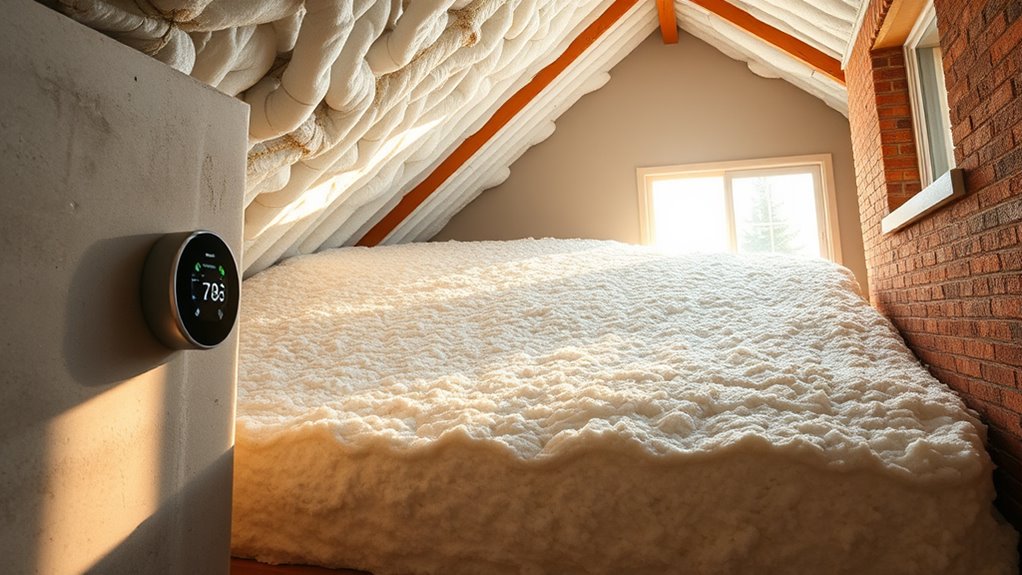
Are you looking for ways to cut energy costs and reduce your carbon footprint? Implementing energy efficiency upgrades can make a real difference in your home’s performance. One of the most effective steps is improving your home’s airtight sealing. When you seal gaps around windows, doors, and other leaks, you prevent warm or cool air from escaping. This means your heating and cooling systems don’t have to work as hard, lowering your energy bills and decreasing your home’s overall energy consumption. Proper airtight sealing also enhances comfort by eliminating drafts and uneven temperatures. Pairing airtight sealing with solar integration can further boost your home’s efficiency. Solar panels harness renewable energy, reducing reliance on fossil fuels, and when your home is well-sealed, the solar system operates more efficiently because the internal environment remains stable. This synergy maximizes energy savings and minimizes your environmental impact.
Sealing gaps and integrating solar boosts home efficiency and reduces energy costs and environmental impact.
Beyond sealing and solar, consider adding insulation to key areas like the attic, walls, and floors. Good insulation acts as a thermal barrier, keeping heat in during winter and out during summer. This reduces the strain on your HVAC system and maintains a consistent indoor temperature. Combining insulation with airtight sealing ensures that conditioned air stays inside and unconditioned air stays out. These upgrades work together to create a more energy-efficient home, saving you money over time. Additionally, incorporating juice cleansing practices can support your overall wellness and energy levels, complementing your commitment to a sustainable lifestyle.
Thermal mass is another upgrade worth exploring. Materials like concrete, brick, or stone absorb and store heat during the day and release it at night. Incorporating thermal mass into your home’s design can naturally regulate indoor temperature swings, reducing the need for active heating and cooling. When used alongside airtight sealing and insulation, thermal mass enhances your home’s ability to maintain a stable climate with less energy input. This means fewer fluctuations and a more comfortable living environment year-round.
Finally, consider upgrading your windows and doors with energy-efficient models. Double or triple-pane windows with low-emissivity coatings can notably cut heat transfer. When combined with airtight sealing, these windows prevent drafts and heat loss, amplifying your home’s overall efficiency. Integrating these upgrades creates a holistic approach to energy conservation, helping you lower utility bills while shrinking your carbon footprint. By focusing on airtight sealing, solar integration, insulation, thermal mass, and high-performance windows, you set your home up for long-term energy savings and environmental benefits.
Frequently Asked Questions
How Do Insulation Types Affect Indoor Air Quality?
You might wonder how insulation types affect indoor air quality impact and insulation health. Different insulation materials can release volatile organic compounds (VOCs) or fibers, affecting air quality and potentially causing health issues. For example, fiberglass insulation may irritate your skin and lungs, while spray foam can emit fumes. Selecting low-VOC, non-toxic insulation options helps guarantee better air quality impact and insulation health for your home’s environment.
What Is the Lifespan of Common Thermal Mass Materials?
You might think thermal mass materials last forever, but their durability varies wildly. For instance, concrete can endure centuries, while adobe might degrade in just a few decades if exposed to harsh elements. Most common thermal mass materials, like concrete and brick, have impressive lifespans—often 50 to 100 years—thanks to their robust nature. Proper maintenance and environment dramatically influence their thermal mass durability and resistance to material degradation over time.
Are Energy Efficiency Upgrades Environmentally Sustainable?
You might wonder if energy efficiency upgrades are environmentally sustainable. Generally, they are, especially when you choose renewable materials that reduce ecological impact. These upgrades often lower energy consumption, decreasing greenhouse gas emissions. By selecting eco-friendly options, you support sustainability and help protect the environment. Overall, making smart upgrades with renewable materials guarantees you improve efficiency while minimizing your ecological footprint.
How Do Climate Zones Influence Upgrade Choices?
Climate zones greatly influence your upgrade choices because they require climate zone adaptation and regional insulation strategies. You should select materials and techniques suited to your area’s temperature extremes and humidity levels. For example, in colder zones, prioritize high R-value insulation, while in warmer zones, focus on reflective barriers. Understanding your climate zone helps you make smarter decisions that improve efficiency, comfort, and sustainability in your home.
What Are the Long-Term Cost Savings of Insulation Improvements?
When considering insulation improvements, a thorough cost benefit analysis shows you’ll save on energy bills over time, making the investment worthwhile. The long-term cost savings depend on upgrade timing—you’ll maximize benefits by upgrading before extreme weather seasons. Proper insulation reduces heating and cooling costs, lowering your energy expenses for years. Ultimately, planning upgrades strategically guarantees you enjoy the greatest savings and comfort while minimizing upfront costs.
Conclusion
Just like a well-tuned orchestra, your home can operate smoothly and efficiently with the right upgrades. By adding insulation, harnessing thermal mass, and making smart improvements, you create a sanctuary that conserves energy and reduces costs. Imagine your house as a fortress, steadfast against the elements yet comfortable inside. With these upgrades, you’ll turn your home into a resilient haven, echoing the timeless harmony of a well-crafted symphony—powerful, balanced, and sustainable.
